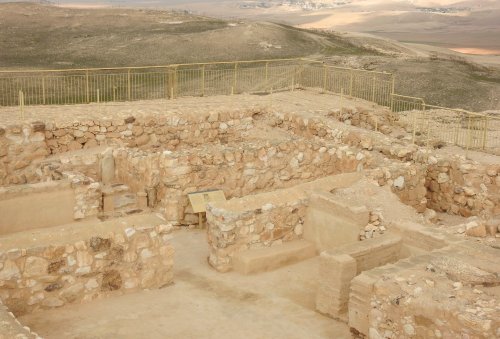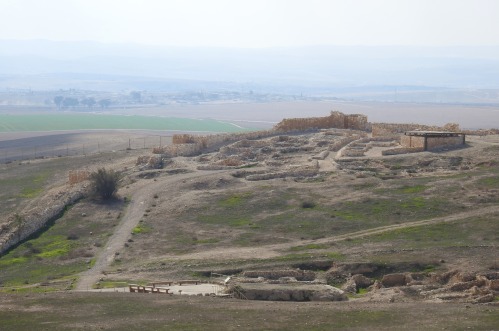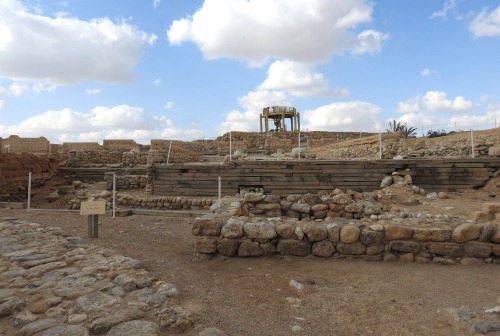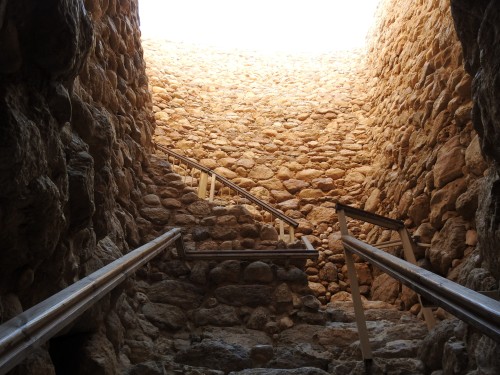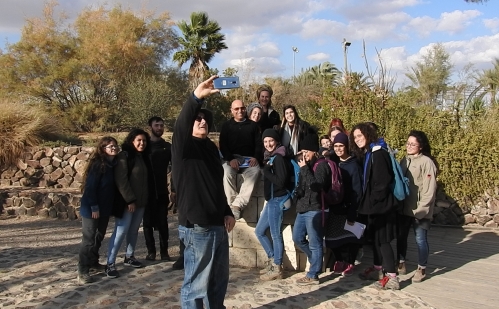Last semester, in the beginning of January, I went on yet another department-run field trip with Prof Aren Maeir. Since I’ve been a trip-going student for several years now, there is an increasingly small list of unique and new field trips being offered to me. However, when I heard of a trip to Tel Arad and Tel Be’er Sheva – of which I’ve been to neither – I jumped to the opportunity.
Our tour bus departed from Bar Ilan University in the morning, and we made our way south toward our first destination: Tel Arad. We arrived just after 9:30 and disembarked, gathering up informational brochures from the front desk, before heading up to the fortress at the top of the tel. I scoured the area for birds, hoping to add a few nice desert-living species to my freshly-started 2020 list. Sure enough, I spotted a mourning wheatear bouncing around the rocky terrain of the national park, joined by a male black redstart.
Atop the tel, Prof Maeir began to educate us about the site that we were about to enter, however, I was much too busy filming and looking for birds to know what was said. As part of my job as media director of my department, I film, edit and release videos of our field trips. You can see the video of this trip HERE, on the department’s YouTube channel (feel free to subscribe HERE!).
Before elaborating on the site, I should add that I tried visiting Tel Arad back when I was a truck driver in the IDF, but didn’t end up having time to explore. So, this trip’s score was to be settled at last. About Tel Arad, the site first saw human occupation in prehistory, with a scattered settlement, and then became a walled city during the Bronze Age. The tel-top fortress was first built in the Iron Age, built and rebuilt numerous times as a result of enemy destruction. In the Hellenistic period the fortress saw an addition of a tower, and the city was only finally abandoned in the Early Arab period (8th century CE). Following surveys conducted by the British in 1874, the site was ultimately excavated in the 1960-80s and established as a national park.
We entered the fortress from the east, and entered the not-so-tall tower, enjoying the lookout over the ancient city. Looking down at the layout of the fortress below us, we saw the warehouses and the temple, with its shrine and altar. There was a bitterly cold wind that whipped at us, driving us down from the lovely lookout and into the partially restored fort interior.
After a quick gander at the subterranean water system and reservoir, where some feral pigeons waited in ambush to burst out at us with a flurry of powerful wingbeats. Not the least bit alarmed, we continued down to what is called the “Canaanite city”, and examined the exposed ruins scattered here and there. I must add that this layout, with the fortress up above and the walled city down below, was greatly pleasing to the eye and I thoroughly enjoyed my visit there.
We followed the park’s recommended trail, bumping into a group from Tel Aviv University, led by Dr Ido Koch, whom our Prof Maeir seemed to know quite well. While outside the typical Aradian house, a broad-room style house, I noticed an interesting turn of events over the western border fence. A hooded crow had spotted two brown-necked ravens coming in, and went over to greet them in the best way possible. A short and anti-climactic aerial battle ensued, and I watched the corvids swoop and dive at one another until at last they all dispersed free of visible injury, but perhaps injured pride.
When we were finished at Tel Arad we got back into our bus and had a nice desert drive over to the second site of the day: Tel Be’er Sheva, located just outside of the city Be’er Sheva. A UNESCO World Heritage Site, the tel is an important site that saw civilisation for a span of thousands of years. There are remnants of settlement from prehistoric times, as well as a pretty continuous occupation in the Iron Age. During the Persian period, in the 5th-4th centuries BCE, a small fortress was built.
Subsequently, in the Hellenstic period, a temple was constructed – the stone base of the altar still visible on-site. The fortress was enlarged in the Herodian period, and then a diamond-shaped fortress was built in the subsequent Roman period, to be restored in the Early Arab period. During the Roman and Byzantine periods, Be’er Sheva’s epicentre moved from the tel to the outlying areas – today, the sprawling modern city. Used by the Ottomans as a staging ground during WWI, the city was conquered by ANZAC troops in 1917.
We entered the site and approached the tel from the east, climbing up into the walled city from the southern gate. Within, the city’s remains – most of them reconstructed – portray a chaotic assemblage of human-built structures, crisscrossed by ancient streets and modern footpaths. Prof Maeir went into great detail as we walked from area to area, while I attempted to capture it all on film.
Several black kites soared overhead at low altitudes, attracted to the rubbish heaps perhaps accredited to the nearby Bedouin encampment, or perhaps the local village Tel as-Sabi. Likewise, a medium-sized mammal (perhaps Indian crested porcupine) had been burrowing under some ancient walls, which amused me to see. The path took us along the inside of the casemate wall until the northwest corner, where it turned in to lead us to the observation tower.
It was atop the tower that I felt a greater understanding of the circular city below me, as I was able to see the layout from a bird’s-eye view – oh, how I envy them! Casting my view out even farther, I spotted an interesting sight from the Bedouin encampment – dozens of dromedary camels alongside scores of fuzzy-looking sheep.
We descended from on high, and made our way into the bowels of the globe – well, not that far, just seventeen metres down into ancient Be’er Sheva’s underground water system. It was nice and cool down below, and like all ancient water systems, quite an engineering feat considering the tools and knowledge the builders possessed.
Video that I filmed of the trip
Finishing our circuit of the ancient city, we stopped at the famous altar’s replica (the original is on display at the Israel Museum) for a quick selfie with the whole group, sans myself who needed to document the documentation. We had a short break and then loaded ourselves back into our bus to be shuttled to our next location: Tel Lachish.
However, being as though I already visited, blogged about and filmed a previous Maeir-led excursion to Tel Lachish (see HERE), I thought I’d sit this one out and instead did some near-sunset birding, and fox-watching, which turned out to be quite enjoyable. I secured a ride back to Jerusalem with the professor and from there to a bus to have dinner with my then-fiancé, Bracha. The day ended as it had begun, with smiles and a resparked thirst for fun, adventurous outings.



